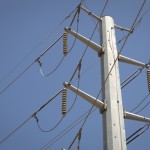Green Experiment Takes Root in Austin

Photo courtesy of Webber Energy Group
Charles Upshaw is researching renewable energy and smart grid technology at the Mueller Development in Austin.
The Mueller subdivision, just northeast of downtown Austin, is recognized as a haven for green building standards, energy conservation and environmentally-sustainable development.
Smart appliance makers, sustainable home developers, renewable energy companies and green home builders are all using the Mueller development as a test ground for some of the most advanced home technologies in America.
StateImpact Texas recently sat down with Charles Upshaw, a mechanical engineering graduate student at the University of Texas at Austin and member of the Webber Energy Group. He’s working with the Mueller Development on residential smart grid applications for home energy management and analyzing energy consumption in homes to improve efficiency.
Q: Can you tell me about the solar energy that you are using there at the Mueller Development?
A: Pecan Street is the smart grid consortium here in Austin. It’s a collaboration between the University of Texas, the City of Austin, Austin Energy and a bunch of companies. In order to really test, and have a real world kind of experiment with high density residential solar, they have offered additional incentives to the [Mueller homeowners] on top of the Austin energy rebate and the federal rebate, so the people in Mueller have an opportunity to get solar really cheaply, less than a dollar a watt and so a lot of them have taken advantage of that… it’s around a megawatt of solar installed or going to be installed in the next few weeks or month.
Q: Is this the biggest solar project inside a single community that you know of?
A: As far as we know, it is the highest density residential solar experiment or deployment in the U.S.
Q: Is every house in Mueller green certified?
A: As far as I’m aware, all the houses are green building certified at several levels. It starts out at green building certified and then they have three, four and five star green built certified. I think all the homes are at least green building certified and then they have some beyond that.
Q: What kind of energy storage systems are being used in Mueller?
A: There will be at least 60 homes, I believe, with battery storage. Sony is putting in batteries. Sony is one of the Industry Advisor Councils for Pecan Street and so they [want] to test some of their own battery technology in these houses. I think they are a little over 1 kilowatt batteries.
Q: Have batteries like this ever been installed in houses before?
A: There are homes with batteries. I think that, as far as I know, this will be the first large-scale deployment with dozens of homes with batteries. Typically, they are for homes that are semi off-grid.
Q: What’s the point of having these batteries?
A: I haven’t gotten straight from Sony what they think their batteries will be primarily used for because [of] the sizing of it. It’s not sized such that it would provide complete power to the home for hours at a time. A typical home in the afternoon in the summer is pulling at least four kilowatts and sometimes it’s eight or ten, depending on the size of the house. So with a one kilowatt battery you wouldn’t be able to provide even an hour of power to the house. But with one kilowatt hour you would be able to potentially ride through any temporary dips in solar output from something like a cloud passing over or anything like that and smoothing things out and not allow big spikes in the grid.
Q: Can you tell me about the smart appliances and electric vehicle chargers that are being installed?
A: I know that there are going to be somewhere around 100 Chevy Volts available to the residents to either buy or lease, and the hope is that we’ll be able to analyze the grid dynamics associate with that. When you typically have electric cars and solar panels and batteries all on the same transformers and all on the same sub-system, it hasn’t really been done in this density before. So, it’s going to be a really interesting, real-world test to see if the grid can stand up to these new technologies. The hope is to have some smart appliances put in that can interface with the home energy management systems that can then be used to automatically optimize or reduce demand when power is expensive.
Q: Mueller will be using advanced electrical meters, what do those do?
A: Advanced smart meters allow for more granular reading than the old traditional meters. Right now, they are taking measurements every 15 minutes, which is better than once a month like the typical old meters. And the advanced smart meters allow for two-way communication between the utility and the homeowner. If they have a home energy management system they can interface with their smart meter then the utility could potentially send pricing signals or other information over their network to the homeowner.
Q: So homeowners would know if and when they were using a loads of expensive energy and could turn things off?
A: [The homeowner] would have a home energy management system communicating with the utility, probably over the smart meter backhaul network or perhaps over the Internet, and the utility is going to be sending real time pricing signals and the home energy management system would take those pricing signals in, look at what’s being used in the house and [and see if it] could be shifted to a later time when energy is cheaper and use all that information with those controls to reduce energy consumption while maintaining quality of life for the homeowner. The hope there would be to reduce the energy consumption, reduce the cost to the utility to operate during those peak hours and still lower the homeowner’s overall energy expenses. So, the goal is to see if we can get a win-win situation for everyone.
Q: What is the most innovative and interesting thing that you see being developed at Mueller?
A: It’s just the idea of trying to find where the extra value is, where the real selling point is to the consumer. Pecan Street and Mueller’s smart grid demonstration is really the only smart grid demonstration project that I’m aware of that has taken this consumer-centric, consumer-electronics approach to it. Where instead of trying to sell it to the consumer through the utility as some sort of energy efficiency thing, they are trying to find a way to make smart grid more useful to the consumer, such that [the consumer] would demand it from their utility or they would even go out and buy it from Best Buy and install it in their house themselves.
